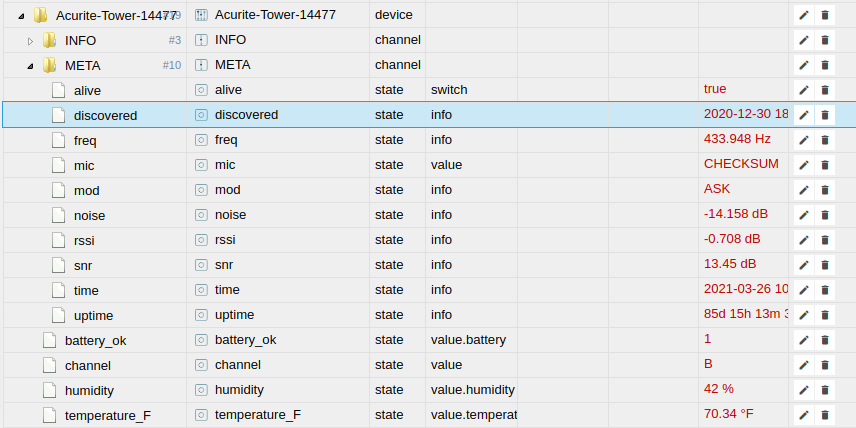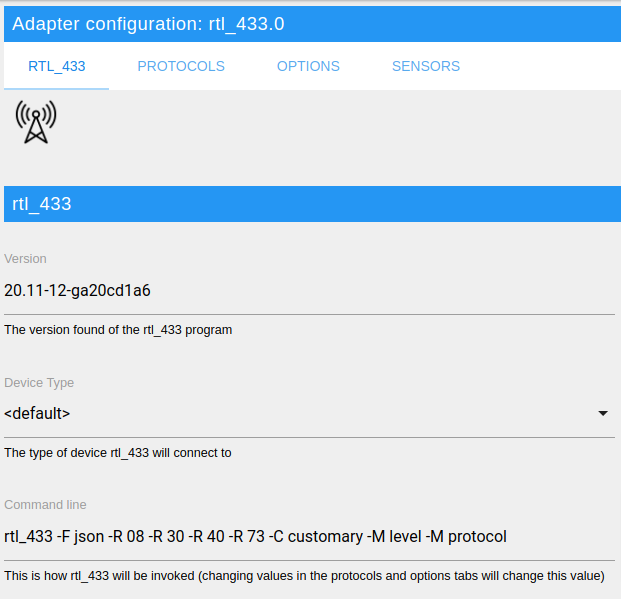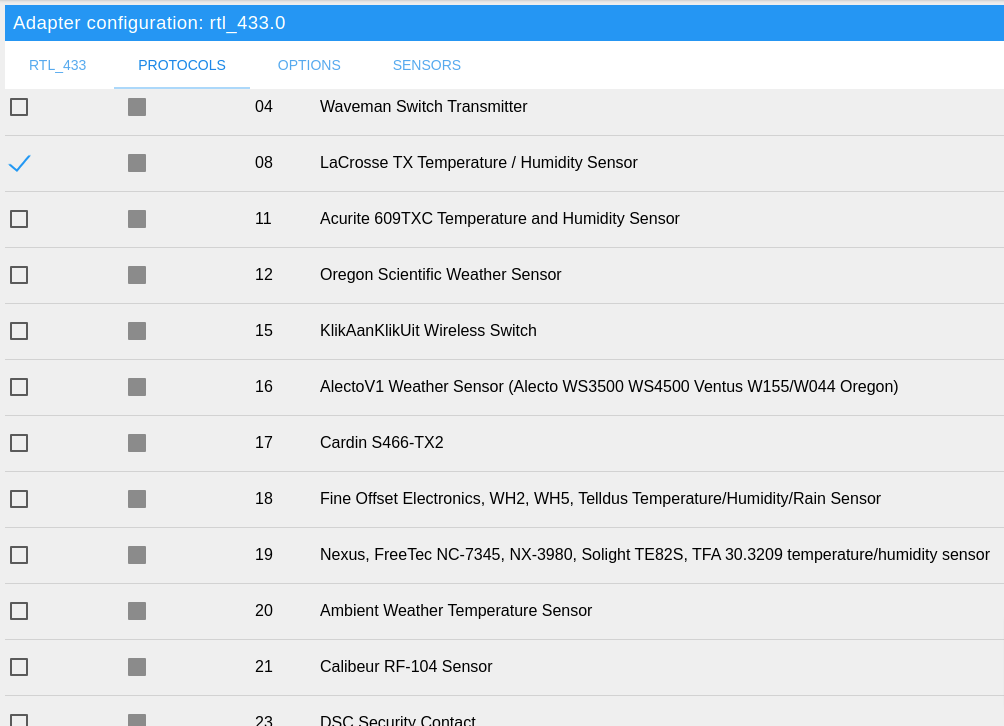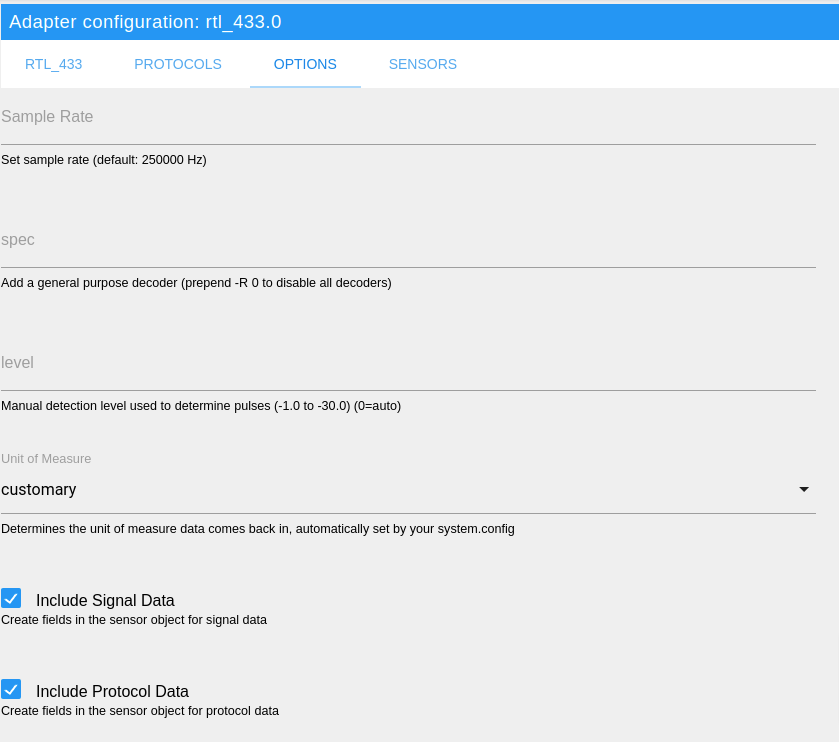@fckw - Thank you, I am trying. I have finally figured out the Travis CI stuff and some of the other things that have been holding me back. I developed the adapter a week after I was introduced to ioBroker ...and the bulk of the conversation about it is in a foreign language to me.
NEWS
Best posts made by phillipssc
-
RE: New Adapter for rtl_433 incoming dataposted in Development
-
New Adapter for rtl_433 incoming dataposted in Development
Hello everyone.
You can check out this adapter, if you wish, at: https://github.com/phillipssc/ioBroker.rtl_433
I am relatively new to ioBroker having just started with it 7 months ago. I previously was running OpenHAB but liked the pure JavaScript approach to ioBroker.
When I saw how the Sonoff adapter was done I was interested if I could do something similar for rtl_433 data. For anyone wondering, rtl_433 builds off of rtl-sdr and uses largely former USB TV Tuner hardware to receive signals in the Rf spectrum (incoming data only). Often this will be at 433 MHz but it is not limited to that frequency. I use this to monitor temperature senders commonly used for weather stations and I have a large number of contact sensors as well. I have been running this adapter for about 6 months now, it is stable.
I created the adapter using the instructions on the site. Starting at: "npx @iobroker/create-adapter iobroker.rtl_433". I have run the utility through the adapter checker at: https://adapter-check.iobroker.in/ the only two errors I currently get are:
[E300] Not found on travis. Please setup travis
1
[W400] Cannot find "rtl_433" in latest repository
1Travis is set up - however it does not pass due to the lack of an RTL-SDR USB stick nor the rtl_433 software in their environment.
The command that fails, "npm run test:integration" passes locally on my worstation. Messages in the log alert the user that the environment needs to be set up and points them to the rtl_433 site https://github.com/merbanan/rtl_433 for installation instructions.I do not believe that my adapter will be in the latest repository until it is accepted by ioBroker at large.
I am trying to get this published using the instructions at https://www.iobroker.net/#en/documentation/dev/adapterpublish.md and this post seems to be the first step

Thanks, feel free to let me know what you think,
Sean -
RE: New Adapter for rtl_433 incoming dataposted in Development
@vogtländer - A new version is up that should let you put multiple frequencies in the configuration separated by a space or comma. The error you saw should be handled and if the adapter is put into debug mode, it should help you identify an improperly created device that is not behaving properly.
-
RE: New Adapter for rtl_433 incoming dataposted in Development
@vogtländer said in New Adapter for rtl_433 incoming data:
That is an interesting error. I will make sure it doesn't happen again in the next version, but one of your objects did not get created correctly.If you can, check to see if you have an object without the discovered parameter in the META section:

Find and delete that object (or enter a date for it) and you should be back in business.
-
RE: New Adapter for rtl_433 incoming dataposted in Development
@vogtländer - I just looked this up on the rtl_433 site. This should be possible with the latest iobroker.rtl_433 adapter.
In the options tab enter the first frequency followed by -f and the second frequency.
e.g. "344975000 -f 433920000". Obviously use your own needed frequencies and ignore the error-check red highlighting.Add a hop interval in the input below the frequency, and you should be set to go.
...or just write out the command line that you want in the rtl_433 tab.
e.g. "rtl_433 -F json -f 344975000 -f 433920000 -H 30 -C customary -M level -M protocol" (Note "-F json" is always needed)
The downside is that the checkboxes won't work correctly in the protocols and options tabs afterwards. They are not important. Only the command line and the three settings in the sensors tab are saved. I will update the adapter to fix this soon, but it should work for you regardless.
-
RE: New Adapter for rtl_433 incoming dataposted in Development
Based on the feedback here and elsewhere, I have updated the adapter in order to hopefully eliminate confusion as well as add capability. The admin interface does some debugging and I believe I have finally done the internationalization - at least to my abilities. The adapter should be overall greatly improved.
Latest posts made by phillipssc
-
RE: New Adapter for rtl_433 incoming dataposted in Development
@wolfi Sorry I missed this. I'm not sure what the test you did makes sense. What happens if you run
rtl_433 -F json -d rtl_tcp://192.168.178.153:1234? -
RE: New Adapter for rtl_433 incoming dataposted in Development
@radi - Sorry I didn't see this sooner.
If you want to use TCP/IP to read an adapter. The remote host with the RTL-SDR dongle must be running rtl_sdr (rtl_tcp is included with the dist). Then on that host you would run the command:
rtl_tcp -a hostname -I <ip address>
On your ioBroker server you will need to run rtl_433 (which also requires rtl_sdr) and configure the instance with the ip address. You can take ioBroker out of the picture for testing and run the command:
rtl_433 -F json -d rtl_tcp://<ip address>:1234
In each case the <ip address> would be the address of the host with the RTL-SDR dongle - presumably 192.168.69.140
From the looks of the log provided rtl_433 is not installed on the ioBroker host yet
-
RE: New Adapter for rtl_433 incoming dataposted in Development
@klassisch "This makes me independent of the location of my ioBroker computer." You can use this as such in this adapter too. Rtl_433 runs on top of Rtl-sdr. You can run rtl_sdr on a Raspberry Pi with the dongle in tcp_ip mode. Feed the params into rtl_433 (which my adapter supports) and it will connect to the remote computer for the data. Better instructions are in my README
-
RE: New Adapter for rtl_433 incoming dataposted in Development
@klassisch said in New Adapter for rtl_433 incoming data:
apter glues the rtl_433
Yes, that's precisely it, and as mentioned incoming messages only
-
RE: New Adapter for rtl_433 incoming dataposted in Development
@vogtländer - It looks like it had to do with unit conversion. It would have been interesting to see what that said - but I will cover it in the next round none the less.
-
RE: New Adapter for rtl_433 incoming dataposted in Development
@vogtländer - What does your command line look like on the first tab of the setup page?
-
RE: New Adapter for rtl_433 incoming dataposted in Development
@vogtländer - A new version is up that should let you put multiple frequencies in the configuration separated by a space or comma. The error you saw should be handled and if the adapter is put into debug mode, it should help you identify an improperly created device that is not behaving properly.
-
RE: New Adapter for rtl_433 incoming dataposted in Development
@vogtländer said in New Adapter for rtl_433 incoming data:
That is an interesting error. I will make sure it doesn't happen again in the next version, but one of your objects did not get created correctly.If you can, check to see if you have an object without the discovered parameter in the META section:

Find and delete that object (or enter a date for it) and you should be back in business.
-
RE: New Adapter for rtl_433 incoming dataposted in Development
@vogtländer - I just looked this up on the rtl_433 site. This should be possible with the latest iobroker.rtl_433 adapter.
In the options tab enter the first frequency followed by -f and the second frequency.
e.g. "344975000 -f 433920000". Obviously use your own needed frequencies and ignore the error-check red highlighting.Add a hop interval in the input below the frequency, and you should be set to go.
...or just write out the command line that you want in the rtl_433 tab.
e.g. "rtl_433 -F json -f 344975000 -f 433920000 -H 30 -C customary -M level -M protocol" (Note "-F json" is always needed)
The downside is that the checkboxes won't work correctly in the protocols and options tabs afterwards. They are not important. Only the command line and the three settings in the sensors tab are saved. I will update the adapter to fix this soon, but it should work for you regardless.



